Throughout Mexico and many parts of Central America the aromas of slow roasted and simmered pork fills the air of corner stalls, markets, and restaurants. Chances are those places are serving up carnitas! Unlike carnitas cooked Tex-Mex style in the US, carnitas in Mexico are often a nose-to-tail phenomenon. That means that a whole pig is used, its skin (in the form of chicharron) and also the innards of the animal. The hungry passerby can choose the parts of the pig they want in a tortilla and the chef will expertly combine different morsels of the pork to create a juicy and rich filling. The tender pork may also be flash cooked on a griddle to get a pit more color and flavor before serving.
Traditionally carnitas serve as way to preserve meat in its own fat, allowing it to hold for longer periods. Like more traditional forms of carnitas it is not uncommon for carnitas today to be cooked using little or no salt. For this reason, food establishments will keep salt, onions, cilantro, lime wedges and some salsa on the side for individuals to custom season their carnitas. However you choose to enjoy carnitas the most important thing is that the meat is tender and succulent and that the pork flavor shines. In the recipe below, I recreated a recipe that I learned in 2018. If cooked right, the dish will not disappoint.
This recipe is inspired by a Mexican chef I had the brief pleasure to work with in Hoboken, New Jersey in 2018. Although she used Aji Panca chilies in her version, the base ingredients are very similar. Moreover, the marinade and cooking methods are quite flexible. The key here is low and slow (covered) preferably in an oven, bbq pit, or in my case a Römertopf clay pot. If you are using a regular pot on a stovetop to cook the meat, make sure that it’s thick, has a sturdy lid, and that it is deep enough to braise the pork. If using the stove top method, I would suggest cutting the roast in half and adding water so that the pork is about half submerged (remember the pork itself will release a lot of juice and flavor). Finally, if you are using a slow-cooker cut the pork into smaller (ping-pong ball size) chunks.
A few side notes: Deboning a pork shoulder is somewhat challenging at first. If this in not in-store for you, simply buy a boneless pork butt (shoulder), this kind of roast is also sometimes called a Boston butt or Boston roast, in the US. If buying from a Mexican store ask for a “paleta de puerco” or a “paleta de cerdo”. For the deboned roast ask for a roast which is “deshuesado”. You should be looking for a nice pink piece of meat with fat interlaced throughout. Let’s get started!


Step one: Rinse meat, remove skin (you can keep the skin for chicharron), debone and try to keep the meat in one piece. Trim a bit of exterior fat (to your liking).

Step 2: Butterfly/fan out so meat can be covered in the marinade and then rolled and tied after.

Step 3: Make the marinade by combining all the ingredients in a food processor (or using a hand mixer). Add onion, dried figs, tomato, dried green chilies, cumin, kosher salt, Sazon creole seasoning (or ground achiote or paprika), crushed black pepper, garlic, coriander stems, and white distilled vinegar. Blend thoroughly until paste/purée is formed.

Step 4: Cover meat with marinade (save a bit to top off the meat), roll together so it is compact, and tie up the meat with butcher twine. Ideally, let marinade for a couple hours or overnight (optional). You do not need to tie up the meat if you are using the stove top method or slow cooker.

Step 5: place meat in either a Römertopf clay pot, a deep baking dish cover meat and dish with foil, a large cooking pot with well-sealed lid (add some water), or in a slow cooker (also add a cup of water here).
Step 6: Depending on the cooking method used and the size of the meat pieces cooking times will vary. To be absolutely sure that you cook the meat check for internal temperatures of 200-210 degrees F or 93.5-98 celsius. The meat should be fork tender and still juicy.
Römertopf: 4-5 hours 300 F
Oven dish: 5-6 hours 300 F
Stove top: 5-6 hours at a simmer (lid must be on while cooking) turn meat once in the middle of the cooking process for even braising.
Slow cooker: 8-10 hours at the middle setting (medium cook).


Once tender, break up or finely chop the meat and place back into the sauce/jus. Serve with tortillas, a garnish of cilantro, onions, and lime wedges, and of coarse you favorite salsa. Check the next posts for salsa recipes.

Marinade:
Half white onion
4 dried black figs
1 tomato
.25 oz mild dried green chili 1.5 tbsp
2-3 teaspoons ground cumin
.25 oz of kosher salt 1.5 tbsp
1 packet of Sazon condimento creolo (can be replaced with tblsp of mild paprika or achiote powder)
Teaspoon black pepper
2 cloves of garlic
1.5 tbsp mild dry green chilli (or red is cool too)
Handful of coriander stems (washed thoroughly)
2 tbsp distilled white vinegar (or apple cider vinegar)

Recent Comments